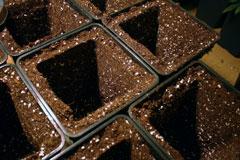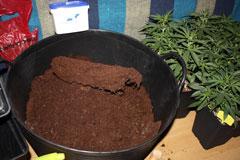All you need to know about transplanting your cannabis plants
Controlling the exact moment when our plants need to be transplanted can contribute to an increase in yield, but it is very important to do it correctly to avoid stressing our cannabis plants.
Next we will share with you all the necessary information for a successful transplant, performed at the right time and with the least errors possible, with the final goal of obtaining healthy and strong plants.
What is the meaning of transplanting?
It is very simple. Transplanting involves moving our cannabis plants from one pot to a new and bigger pot. The development of cannabis plants is mainly conditioned by the genetic traits. However, the structure that the roots can adopt can also influence the way plants grow. For example, if the root system is wide, but not very deep, the plant will tend to grow in width, as a bush. On the other hand, if your root system is deep and narrow, the plant will tend to be more stretchy and less branched sideways. Therefore it is very important to select the right pot to grow your cannabis plants.
Why is it important to transplant your cannabis plants?
Whether indoor or outdoor, the roots need darkness, moisture, oxygen and space to properly develop. When it comes to cannabis, the roots tend to develop towards the sides and the bottom of the pot, so if we start with a big pot, the roots will not be well distributed, developing towards the edges and bottom, leaving uncolonized areas. The transplant will help the roots to develop along the soil mix in a more uniform and optimal way, improving the ability to obtain nutrients.
Another consequence of using high capacity containers since the beginning is the ability of the soil to retain higher amounts of water for a longer period of time, which can lead to excessive humidity in the soil.
A lot of growers ask if the size of the pot interferes with the development of the cannabis plant. No doubt it does, so transplanting your cannabis plants will help them to develop their roots in an optimal and homogeneous way.
Transplanting autoflowering cannabis plants
At Sweet Seeds® we do not recommend transplanting autoflowering strains. We recommend growing them directly in the final pot or transplanting the plant to its final pot within the first two weeks after germination, avoiding any stress that could affect its growth and development.
If you decide to transplant your autoflowering cannabis plants, here you have all the important information about it.
As you may well know, autoflowering seeds, also known as automatic, offer us cannabis plants that flower regardless of the photoperiod they are subjected to. They start flowering according to their age and their life cycle.
For autoflowering growers, the size of the pot that they should use is always a very interesting topic of debate. As autoflowering plants do not produce wide root systems, initially we do not need big pots. So, after germination they should be placed in a small pot (between 300ml and 500ml) ensuring that the pots do not retain too many humidity while there will be plenty of oxygen in the soil during the first weeks of growth. A lack of oxygen could lead to a slower development of the plants, to deficiencies or even to the appearance of a mould attack.
It is very important to consider that due to the fast development of autoflowering strains, any stress that could affect the plant in the first weeks of life could significantly affect its growth and final yield.
When our autoflowering plants complete 17 days of life, it would be the ideal moment to transplant them to the final pot, which should be of at least 5 to 10 litres and a maximum of 20 litres.
The transplant should be performed with extreme care and attention, without damaging the roots of the cannabis plants. Besides that, it is important to use a soil with the adequate characteristics for the best development of the plants and their roots. If you want to take the chance, this is the ideal timing to add bacteria and beneficial fungus to the root system, such as mycorrhizae and trichoderma, which usually help in the development and protection of the roots.
What do we need to perform a transplant?
To carry out our transplants we will need the following items:
- Pots: We need to have the corresponding pots. It is very important that these are previously disinfected before use to avoid any infection or disease in the roots.
- Soil: Make sure that you have the necessary amount of soil for the new pot. It is advisable to use a soil with the appropriate characteristics.
- Gloves: Using latex gloves helps to a better cleaning and to avoid root contamination.
- Root stimulator (Optional): It will improve the development of the roots while helping to balance the stress caused during the transplant.
- Mycorrhizae y trichoderma (Optional): During the transplant we can add these bacteria and fungi to the root ball of the plant as they are beneficial for the development and protection of the roots.
When should we transplant our photoperiod-dependent cannabis plants?
Photoperiod-dependent seeds, as the name suggests, are strains that depend on the photoperiod to start the flowering stage, which is triggered with the arrival of short days and long nights. In indoor growing with artificial lights the flowering stage is usually started and maintained by supplying the plants with a daily photoperiod of 12 hours of light and 12 hours of darkness until its harvest.
The F1 Fast Version® strains are 100% photoperiod-dependent plants featuring ultrafast flowering which are ready to harvest 1 to 2 weeks earlier than their original versions. For this reason they are the right choice for growing operations in rainy or humid areas that are especially vulnerable to the occurrence of mould attacks.
In this type of plants, the transplant could be carried out in the same way as in the rest of the photoperiod-dependent plants, but it is very important to take into account the timings of its life cycle and avoid to carry out any transplant once the flowering period has started. It may be that for being faster they require fewer transplants than the other photoperiod-dependent strains, depending on the strains.
Transplanting outdoors:
The regular season to start the outdoor growing of cannabis is during spring and to decide when to germinate our photoperiod-dependent seeds we have to take in consideration that the earlier we start, the more time the plant will grow. The best months to germinate Sweet Seeds® photoperiod-dependent seeds to grow in pots are: April, May and June.
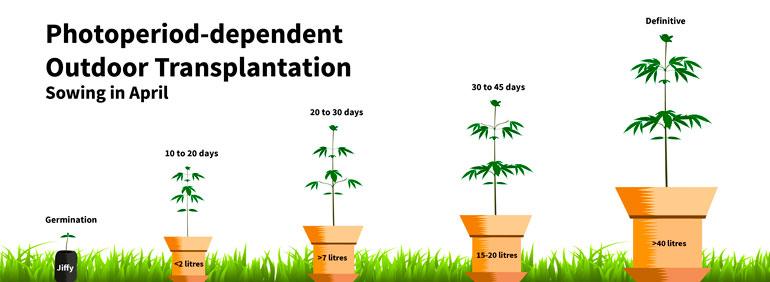
First transplant:
- Germinating in April, May and June:About a week and a half after the germinated seed is planted, when we observe between 4 and 5 groups of leaves, we will pass the plants to a pot of at least 2 litres. Then we wait between 10 and 20 days to perform the second transplant.To determine the right time to perform the following transplants, we will have to look at the height of the plant and compare it with the height of the pot. If the height of the plant multiplies by 1.5 the height of the pot and the roots already covered most of the substrate, it is time to transplant it to a larger medium. Another method would be checking if the pot is completely colonized by the roots.
Second transplant:
- Germinating in April or May: When the plant has reached a height higher than the pot, it is time to transplant it to a pot of at least 7 litres, leaving it then in its new pot for 20 or 30 days.
- Germinating in June: After 10 to 20 days of the first transplant and before the flowering period begins and / or we see the first pre-flowers, we will pass the plant to its final pot that should be of over 40 litres.
Third transplant:
- Germinating in April: We transplant our cannabis plant into a pot of about 15 to 20 litres and leave it there for a month or a month and a half.
- Germinating in May: The plant is transplanted to the final pot that will be of over 40 litres. You always have to perform this last transplant before the plant starts flowering.
Fourth transplant:
- Germinating in April: This would be the last transplant, to a pot of over 40 litres, but it must be done before the flowering stage begins.
You should always consider that when you transplant a cannabis plant to the final pot, the higher capacity of the pot, the bigger and taller the plant will be, always depending on the different grow parameters, such as the quality of the soil, the fertilizers used, the total light time, etc.
Transplanting indoors:
In this type of grow operations we are able to control the exact moment in which the plant starts flowering. You can choose to perform 2 or 3 transplants to your cannabis plants.
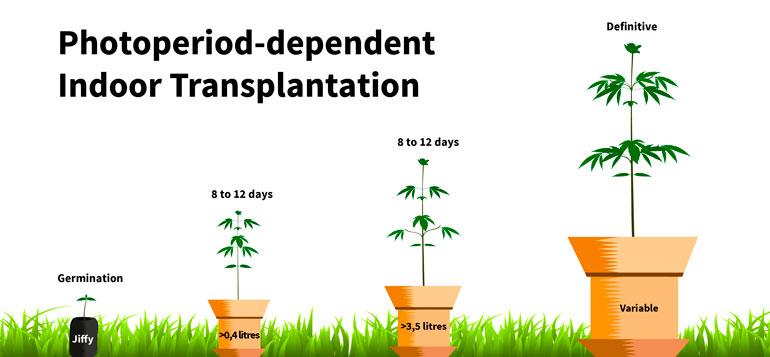
- First transplant: After germination the seedling is passed from its original medium (rock wool, jiffy, etc) to a pot of at least 0.4 litres. We will leave the plant in the new container for about 8 to 12 days.
- Second transplant: After 8 to 12 days we will carry out the transplant to a pot with a minimum capacity of 3.5 litres. We will leave the plant in this new pot for another 8 to 12 days, or until the soil is completely colonized by the roots.
You may decide to do only two transplants. If this is the case, you will have to transplant to the final pot in a early stage and always depending on the pot capacity, number of harvested plants, lighting, etc.
- Third transplant: For this third transplant, we will change the plant to its final pot, whose capacity should depend on the number of plants grown, lighting used, space available and / or the type of strain (autoflowering or photoperiod-dependent).
How to transplant your cannabis plant?
Once we have prepared and disinfected all the necessary items we will prepare the new pot where the cannabis plant will be transplanted to. We have to fill it with a good quality soil, approximately up to half the container, which we will lightly press to obtain a good consistency for the roots.
Now, with great care we will take the plant firmly by the base of its stem with one hand, overturning the pot to extract the plant completely from its old pot. You will be able to observe the root ball formed by the soil and the root system. Then, with great care and delicacy, the plant is placed upright in its new pot, filling the space between the root ball and the new pot with soil. And now we just have to wait for the plant to adapt to its new growth space.

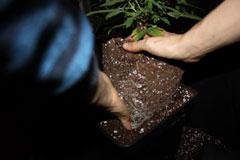
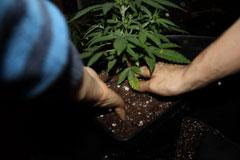
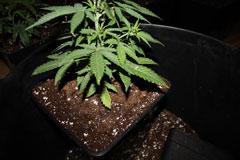
Conclusion
Remember that the transplant process is a delicate process and that it can directly affect our plant. Making any mistake can cause slow growth or in the worst case growth can even stop and we lose our plant. So it is very important that before doing any transplant you know very well the cannabis life cycle in order to determine the exact moment in which you should carry out the transplant of your plants. Pay attention to how your plants react after these changes and try to do it with the greatest care and patience possible. Then your cannabis plant will thank you with a very sweet reward.
Sweet Seeds S.L is not responsible for the misuse of the information contained in this article. Cultivation of cannabis may constitute a criminal offence or administrative misdemeanour; please refer to the legislation on cannabis in your place of residence. Sweet Seeds S.L. does not intend in any case to incite non-legal practices.

